Inspired by Heinkel models, the all-metal cantilever monoplane twin engine reconnaissance Tupolev R-6 was also used by the Navy as the MR-6, equipped with floats. MR-6 stands for Morskoj razvyedchik, maritime reconnaissance (also sometimes called “KR-6P”). It was also used as a torpedo bomber version from 1932 and still used for training in 1939-40. It was retired in 1942 for good. The MP-6 2M-17 was a seaplane passenger transport powered by two 507.1 kW (680 hp) Mikulin M-17 V-12 engines.

But the ANT-7 was not a true bomber. It was merely another experimental aircraft reusing some of the same techniques. The ANT-4 (produced as the TB-1) had its prototype in flight by 1925, and it was decided to improve in performances, which led to a scaling down essentially, leading to the development of the ANT-7, which first flew on 20 October 1929.
To place it in the right lineage, Tupolev's models could be listed as such:
Tupolev ANT-1: First wood-aluminium tiny prototype (FF 20 October 1923)
Tupolev ANT-2: Small monoplane passenger plane, 6 made (FF 26 May 1924)
Tupolev ANT-3: Main reconnaissance monoplane, 105 made (FF 6 August 1925)
Tupolev ANT-4: Prototype for the first soviet bomber, the TB-1 (FF 1925)
Tupolev ANT-5: Prototype single seat fighter, built at the I-4, 369 made (FF 1927)
Tupolev ANT-6: Prototype for the next bomber, TB-3 (FF 22 December 1930)
Tupolev ANT-7: Our current Reconnaissance model.
The ANT-7 is actually anterior to the TB-3. It was designed as a scaled down version of the TB-1 bomber, tasked as a reconnaissance model and ...escort fighter. In the name, Tupolev R-6, "R" stands for "razvedchik", reconnaissance. It traces its roots by early 1928 when the Soviet Air Force requested a long-range multirole aircraft, usable for long-range transport, defensive patrolling, reconnaissance, light bombing and even torpedo attack. A "jack of all trade" with the risk (easier to see with indsight) of a model that would end as good at nothing.
The first flight of the ANT-7 took place on 11 September 1929, piloted by Mikhail Gromov. Flight tests started in March 1930 after TsAGi decided to postpone them until after the winter. That summer, the NII-VVS (Nauchno-Issledovatel'skiy Institut Voyenno-Vozdooshnykh Seel – air force scientific test institute) conducted state tests which revealed tailplane buffeting, which was alleviated by fitting enlarged elevators. The next flight encountered radiator damage and an engine failure, but in spite of this, the ANT-7 passed the state acceptance tests.
The lead R-6 was tested on October 5, 1931. On the second serial one, Short-type floats were installed, with them the aircraft passed state tests and could be used as a multi-seat fighter, air cruiser, long-range naval reconnaissance and torpedo bomber. At the beginning of 1933, the floatplane was tested with various variants of mine and torpedo armament. It was designated MR-6 and was mass-produced at the Taganrog plant No. 45. In 1934, the production of MR-6 was transferred to Moscow, and sometimes called from there KR-6P.
In civil and polar aviation, it was designated MR-6 and was widely used, mainly in the North and Siberian river airlines until 1945. It is not known exactly how many of the 400 serial ANT-7s were put on floats althugh 150 is the most common figure given.
The first flight of the ANT-7 took place on 11 September 1929, piloted by Mikhail Gromov. Flight tests started in March 1930 after TsAGi decided to postpone them until after the winter. That summer, the NII-VVS (Nauchno-Issledovatel'skiy Institut Voyenno-Vozdooshnykh Seel – air force scientific test institute) conducted state tests which revealed tailplane buffeting, which was alleviated by fitting enlarged elevators. The next flight encountered radiator damage and an engine failure, but in spite of this, the ANT-7 passed the state acceptance tests.
The lead R-6 was tested on October 5, 1931. On the second serial one, Short-type floats were installed, with them the aircraft passed state tests and could be used as a multi-seat fighter, air cruiser, long-range naval reconnaissance and torpedo bomber. At the beginning of 1933, the floatplane was tested with various variants of mine and torpedo armament. It was designated MR-6 and was mass-produced at the Taganrog plant No. 45. In 1934, the production of MR-6 was transferred to Moscow, and sometimes called from there KR-6P.
In civil and polar aviation, it was designated MR-6 and was widely used, mainly in the North and Siberian river airlines until 1945. It is not known exactly how many of the 400 serial ANT-7s were put on floats although 150 is the most common figure given.
Fortunately when this version came about, defects of the early R6 has been fixed, mainly: Transverse stability unsatisfactory, mediocre forward view, as well on the sides, hindered by engines. When diving excessive load on steering, difficult aiming at a target when bombing at level flight due to absence of windows in the cockpit floor, no internal means of communication for the crew. Pilot's foot control pedals uncomfortable. For maintenance, dirt clogging into the crutch logding, upper hinged hood not fixed in the raised position, no hatches above the oil tanks, magneto access difficult, radiator shutters too tight and constantly leaking. Corrections started in early 1932 and the Air Force Research Institute reported it was necessary to declare "the very low quality of aircraft production";
The total weight was 10,229 lb empty but it could go up to take-off Weight of 14,132 lb. She was large for reconnaissance model with a generous Wingspan of 76ft 1,38in, a fuselage lenght of 52ft 5,91 in and wing area of 861.11 ft2. The particular of her Mikulin M-17f rated for 720 hp was to drive two-bladed wooden propellers. This was not a marriage in heaven as the engine developed issues, and the model was way to slow and unwieldy as a multirole fighter. Her time to altitude was 19,67 min to 9,843 ft with was laughable as interception was concerned. She could climb at 16,404 ft which was adequate to avoid AA fire in reconnaissance.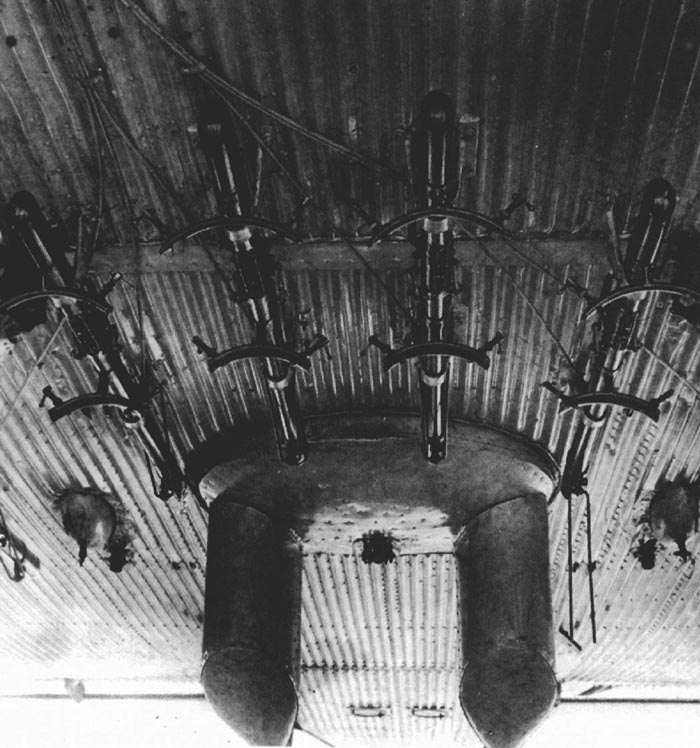 Belly bomb attachment points and ventral frames to keep the torpedo stable (it was only tested)
It was limited to two to three defensive MGs 7.62mm DA-2 Degtyaryov. The flexible arms at the bow and middle positions could receive flexible mounts, twin forward and single dorsal. This was judged adequate for the time, but ludicrously weak in WW2. Designed as reconnaissance machines first, these planes only carried a limited amount of bombs, just 500 kgs (424 lb of bombs), generally small 50 kgs models attached underbelly as there was no bomb bay.
Belly bomb attachment points and ventral frames to keep the torpedo stable (it was only tested)
It was limited to two to three defensive MGs 7.62mm DA-2 Degtyaryov. The flexible arms at the bow and middle positions could receive flexible mounts, twin forward and single dorsal. This was judged adequate for the time, but ludicrously weak in WW2. Designed as reconnaissance machines first, these planes only carried a limited amount of bombs, just 500 kgs (424 lb of bombs), generally small 50 kgs models attached underbelly as there was no bomb bay.
R-6M could also be retroffited with a ski chassis. Equipment was spartan, with an AN-2 compass, speed indicator, altimeter, Jaeger watch, air thermometer and NV-5 navigation sight. The pilot's dashboard had tachometers, thermometers and water and oil pressure gauges asw ell as gasoline gauge glasses, direction indicators, speed indicators, altimeter, clock, AL-2 compass. There was also a Pote 1B camera for reconnaissance in the nose gunner position. The R-6 remained a very costly model at 253,000 rubles (price oif the R-6M is unknown). This was still less than a TB-3 (450,000).
Insufficient visibility on taxiing was a problem for land-based models, but less for the MR-6 which had unlimited surface. This was acite on the right as the pilot's seat was located to the left. The floatplane also inherited poor maintenance regonomics: Technicians complained about inconvenient access to a number of parts and assemblies. The greatest sources of issues were in the engines, and radio stations. BMW VI motors assemblies sometimes sheered off in flight. The propeller flew off along with a piece of the shaft. Cracks were also recorded in the bracket of the rudder column and at the front stabilizer mount. There was also the poor quality of the paint. All MR6 shared woth the land bomber the same two-tones, upper surfaces in standard olive green and undersurfaces o, pale blue. Howver the paint quickly peeled and fell off. New nitro enamels were introduced on the latter production which adhered better to metal.

MR-6 used in polar exploration (old boxart rendition, unknown src)
Records impossible to find for now. It entered service in 1933 and gradually filled squadrons until 1935. By 1940 it was still in service, albeit completely obsolete and already replaced in its role by the Beriev MBR-2. It seems the last operated on the far east (Pacific), including in transport roles until the lack of spare parts condemned them. The larger Tupolev G6 was considered more sucessful in this role. As for the standard ground-based R6 it saw service in the Winter War and in the the early months of the Great Patriotic war. A very few of the 411 produced from 1931 to 1934 survived into 1943 if any. Probably also used as transport far from the frontline as it was an easy prey.
However there is another way this model gaine popularity: The Polar expedition of 1935. Painted in bright orange with aeroflot identifiers (see the illustration). It was organized by the Arctic institute in order to find new exploitable routes for merchant traffic while two ships explored the Kara sea. The plane sent was a modified MR-6 with pilots Volopianov, Liapidevski planned to fly from the Neva in moskow to Cape Schmidt, opposite Alaska and back in the summer, over 25,000 miles.
The Tupolev reconnaissance seaplane
The Tupolev TB-1 was the first mass-produced, modern bomber of the USSR, declined later as a seaplane variant called the TB-1P. However to this very first model from the great designer was soon added a new, lighter one called the ANT-7. Andrei Nikolayevich Tupolev (1888, Pustomazovo, Kimry) specialized in aerodynamics under Nikolay Zhukovsky and teatcher by 1920 at the Moscow Higher Technical School, then prominent figure at the Central Aerohydrodynamic Institute (TsAGI) until 1972, later director. He was fond of the construction techniques developed by Hugo Junkers and in 1925, designed the first modern Soviet twin-engine bomber called TB-1.
But the ANT-7 was not a true bomber. It was merely another experimental aircraft reusing some of the same techniques. The ANT-4 (produced as the TB-1) had its prototype in flight by 1925, and it was decided to improve in performances, which led to a scaling down essentially, leading to the development of the ANT-7, which first flew on 20 October 1929.
To place it in the right lineage, Tupolev's models could be listed as such:
Tupolev ANT-1: First wood-aluminium tiny prototype (FF 20 October 1923)
Tupolev ANT-2: Small monoplane passenger plane, 6 made (FF 26 May 1924)
Tupolev ANT-3: Main reconnaissance monoplane, 105 made (FF 6 August 1925)
Tupolev ANT-4: Prototype for the first soviet bomber, the TB-1 (FF 1925)
Tupolev ANT-5: Prototype single seat fighter, built at the I-4, 369 made (FF 1927)
Tupolev ANT-6: Prototype for the next bomber, TB-3 (FF 22 December 1930)
Tupolev ANT-7: Our current Reconnaissance model.
The ANT-7 is actually anterior to the TB-3. It was designed as a scaled down version of the TB-1 bomber, tasked as a reconnaissance model and ...escort fighter. In the name, Tupolev R-6, "R" stands for "razvedchik", reconnaissance. It traces its roots by early 1928 when the Soviet Air Force requested a long-range multirole aircraft, usable for long-range transport, defensive patrolling, reconnaissance, light bombing and even torpedo attack. A "jack of all trade" with the risk (easier to see with indsight) of a model that would end as good at nothing.
Development of the R-6
Under Ivan Pogosski and guided by Andrei Tupolev, TsAGI developed the ANT-7 from the Tupolev TB-1 by scaling it down by about one third.[1] Power for the ANT-7 was intended to be provided by two 388 kW (520 hp) – 455 kW (610 hp) Hispano Suiza engines or 313 kW (420 hp) Bristol Jupiter engines, but the prototype was powered by two 373 kW (500 hp) – 529 kW (709 hp) BMW VI engines.The first flight of the ANT-7 took place on 11 September 1929, piloted by Mikhail Gromov. Flight tests started in March 1930 after TsAGi decided to postpone them until after the winter. That summer, the NII-VVS (Nauchno-Issledovatel'skiy Institut Voyenno-Vozdooshnykh Seel – air force scientific test institute) conducted state tests which revealed tailplane buffeting, which was alleviated by fitting enlarged elevators. The next flight encountered radiator damage and an engine failure, but in spite of this, the ANT-7 passed the state acceptance tests.
The floatplane Variant: MR-6 or KR-6P
MR-6 standard for "Morskoj razvyedchik", maritime reconnaissance, torpedo bomber version of 1932. KR-6P was an alternative designation found in many sources. It was basically the float-equipped version of the multi-purpose reconnaissance aircraft already under construction was a reduced copy of the TB-1 with the same M-17 engines.The lead R-6 was tested on October 5, 1931. On the second serial one, Short-type floats were installed, with them the aircraft passed state tests and could be used as a multi-seat fighter, air cruiser, long-range naval reconnaissance and torpedo bomber. At the beginning of 1933, the floatplane was tested with various variants of mine and torpedo armament. It was designated MR-6 and was mass-produced at the Taganrog plant No. 45. In 1934, the production of MR-6 was transferred to Moscow, and sometimes called from there KR-6P.
In civil and polar aviation, it was designated MR-6 and was widely used, mainly in the North and Siberian river airlines until 1945. It is not known exactly how many of the 400 serial ANT-7s were put on floats althugh 150 is the most common figure given.
Development of the R-6
Under Ivan Pogosski and guided by Andrei Tupolev, TsAGI developed the ANT-7 from the Tupolev TB-1 by scaling it down by about one third. Power for the ANT-7 was intended to be provided by two 388 kW (520 hp) – 455 kW (610 hp) Hispano Suiza engines or 313 kW (420 hp) Bristol Jupiter engines, but the prototype was powered by two 373 kW (500 hp) – 529 kW (709 hp) BMW VI engines.The first flight of the ANT-7 took place on 11 September 1929, piloted by Mikhail Gromov. Flight tests started in March 1930 after TsAGi decided to postpone them until after the winter. That summer, the NII-VVS (Nauchno-Issledovatel'skiy Institut Voyenno-Vozdooshnykh Seel – air force scientific test institute) conducted state tests which revealed tailplane buffeting, which was alleviated by fitting enlarged elevators. The next flight encountered radiator damage and an engine failure, but in spite of this, the ANT-7 passed the state acceptance tests.
The floatplane Variant: MR-6 or KR-6P
MR-6 standard for "Morskoj razvyedchik", maritime reconnaissance, torpedo bomber version of 1932. KR-6P was an alternative designation found in many sources. It was basically the float-equipped version of the multi-purpose reconnaissance aircraft already under construction was a reduced copy of the TB-1 with the same M-17 engines.The lead R-6 was tested on October 5, 1931. On the second serial one, Short-type floats were installed, with them the aircraft passed state tests and could be used as a multi-seat fighter, air cruiser, long-range naval reconnaissance and torpedo bomber. At the beginning of 1933, the floatplane was tested with various variants of mine and torpedo armament. It was designated MR-6 and was mass-produced at the Taganrog plant No. 45. In 1934, the production of MR-6 was transferred to Moscow, and sometimes called from there KR-6P.
In civil and polar aviation, it was designated MR-6 and was widely used, mainly in the North and Siberian river airlines until 1945. It is not known exactly how many of the 400 serial ANT-7s were put on floats although 150 is the most common figure given.
Fortunately when this version came about, defects of the early R6 has been fixed, mainly: Transverse stability unsatisfactory, mediocre forward view, as well on the sides, hindered by engines. When diving excessive load on steering, difficult aiming at a target when bombing at level flight due to absence of windows in the cockpit floor, no internal means of communication for the crew. Pilot's foot control pedals uncomfortable. For maintenance, dirt clogging into the crutch logding, upper hinged hood not fixed in the raised position, no hatches above the oil tanks, magneto access difficult, radiator shutters too tight and constantly leaking. Corrections started in early 1932 and the Air Force Research Institute reported it was necessary to declare "the very low quality of aircraft production";
Design in Detail
General construction
The R-6 is a low-wing twin-engine cantilever monoplane. Twin-Engine, left and right in the wings. This was an aerodynamic design, used by A.N. Tupolev on most military aircraft of that time, and given his study of Junkers designs, it was an all-metal construction, mostly made of corrugated-aluminum. These corrugated sheets had a thickness of 0.3-0.8 mm and each channel measured 32 mm.The total weight was 10,229 lb empty but it could go up to take-off Weight of 14,132 lb. She was large for reconnaissance model with a generous Wingspan of 76ft 1,38in, a fuselage lenght of 52ft 5,91 in and wing area of 861.11 ft2. The particular of her Mikulin M-17f rated for 720 hp was to drive two-bladed wooden propellers. This was not a marriage in heaven as the engine developed issues, and the model was way to slow and unwieldy as a multirole fighter. Her time to altitude was 19,67 min to 9,843 ft with was laughable as interception was concerned. She could climb at 16,404 ft which was adequate to avoid AA fire in reconnaissance.
Wings
The wing consisted of a center section, integral with the middle part of the fuselage, and two detachable consoles. The longitudinal set of the wing included four spars and stringers. The spars were flat tubular diagonal trusses passing to the end of the wing into beams into the stamped walls were connected by tubular shelves. The latter were made of telescopic aluminum chain pipes of various sections. Ribs for the truss wing were installed in meter increments, made from profiles of the same metal. The joints located along the ribs were closed from the outside with U-shaped profiles. The wing was equipped with large ailerons, consisting of aluminum mail tubular spars, and corrugated skin. Ailerons had minor axial aerodynamic compensation, large horn aerodynamic compensator that protruded beyond the span of the console. They were very thick, 20% at the root, but had a general flat-convex wing profile developed specifically for heavy aircrafts by Tupolev.Fuselage
The fuselage consisted of three sections, the nose, middle and tail bolted together. That way they can be transported by rail and assembled in another facility if needed. The structure used truss, riveted from chain-aluminum pipes and covered by a thin corrugated sheeting. The bow comprised the cockpit for the observer/machine-gunner manning a twin machine gun on flexible mount in open air and behind it was the cockpit proper. A second machine-gun installation, same flexible twin mount, was located in the middle (dorsal) and a third on top of the tail section of the fuselage. The tail unit resembled a wing, having a tray stabilizer to ensure balance in different flight modes, and its angle could be changed within 5 degrees. This was done by a screw jack connected by a control cable and steering wheel in the cockpit.Floats and Specifics
The only difference between the R-6 and MR-6 was the removal of the undercarriage struts and chassis. Openings were plated over, instead two floats were installed under the wings, but to be exact, attached and located to the engines nacelles by "V" type struts and two more connecting the fuselage underbelly to the floats. They were serrated for the crew to access the fuselage from the floats. This simple configuration enabled easy conversion.Crew
The R-6 crew initially consisted of four crew members in max configuration: A pilot, bow MG-gunner/navigator, middle MG-gunner and radio/bombardier. But in reconnaissance missions it could be reduced to the pilot and bow gunner.Motorization
The powerplants were water-cooled fixed-pitch wooden propellers (the model changed, see notes). Each motor mount, welded from steel pipes, was attached to the center section with four bolts. Water radiators were located in the engine nacelles under the engines. The fuel tanks were made of stressed-aluminum and of riveted construction in the wing, placed on cradles and fastened with metal tie-down bands. Like the R-6, sharing everything but the floats. Different motors were installed on production models such as the BMW VIE6.0 and VIE7.3 then M-17 and M-17B. It is not known if some R-6M had BMW engines, but since they were more powerful and lighter, these usually became squadron or flight commanders.Armament
 Belly bomb attachment points and ventral frames to keep the torpedo stable (it was only tested)
It was limited to two to three defensive MGs 7.62mm DA-2 Degtyaryov. The flexible arms at the bow and middle positions could receive flexible mounts, twin forward and single dorsal. This was judged adequate for the time, but ludicrously weak in WW2. Designed as reconnaissance machines first, these planes only carried a limited amount of bombs, just 500 kgs (424 lb of bombs), generally small 50 kgs models attached underbelly as there was no bomb bay.
Belly bomb attachment points and ventral frames to keep the torpedo stable (it was only tested)
It was limited to two to three defensive MGs 7.62mm DA-2 Degtyaryov. The flexible arms at the bow and middle positions could receive flexible mounts, twin forward and single dorsal. This was judged adequate for the time, but ludicrously weak in WW2. Designed as reconnaissance machines first, these planes only carried a limited amount of bombs, just 500 kgs (424 lb of bombs), generally small 50 kgs models attached underbelly as there was no bomb bay.
Other equipments
Electrical equipment was partly domestic and imported. Those with German engines were fully equipped with German electrical systems and dependeincies, but some with M-17 engines could have both. From 1932 oil tanks were increased to 60 liters, with pneumatic starters.R-6M could also be retroffited with a ski chassis. Equipment was spartan, with an AN-2 compass, speed indicator, altimeter, Jaeger watch, air thermometer and NV-5 navigation sight. The pilot's dashboard had tachometers, thermometers and water and oil pressure gauges asw ell as gasoline gauge glasses, direction indicators, speed indicators, altimeter, clock, AL-2 compass. There was also a Pote 1B camera for reconnaissance in the nose gunner position. The R-6 remained a very costly model at 253,000 rubles (price oif the R-6M is unknown). This was still less than a TB-3 (450,000).
Issues
The maneuverability of the R-6, horizontally and vertically, was very limited and akin to the TB-1, and so, completely unacceptable for a multirole fighter. It still could escape a foe, thanks to its robust construction, with a dive angle up to 60°. When making a resource, it started to shaks, with deformations of the tail section of the fuselage. The test pilot even tried to make a loop, but there was a complete breakdown of the rudder columns.Insufficient visibility on taxiing was a problem for land-based models, but less for the MR-6 which had unlimited surface. This was acite on the right as the pilot's seat was located to the left. The floatplane also inherited poor maintenance regonomics: Technicians complained about inconvenient access to a number of parts and assemblies. The greatest sources of issues were in the engines, and radio stations. BMW VI motors assemblies sometimes sheered off in flight. The propeller flew off along with a piece of the shaft. Cracks were also recorded in the bracket of the rudder column and at the front stabilizer mount. There was also the poor quality of the paint. All MR6 shared woth the land bomber the same two-tones, upper surfaces in standard olive green and undersurfaces o, pale blue. Howver the paint quickly peeled and fell off. New nitro enamels were introduced on the latter production which adhered better to metal.
⚙ PLANE specifications | |
| Gross Weight | Empty 3,865 kgs |
| Max Takeoff weight | 6,472 kgs |
| Lenght | 14.75 m |
| Wingspan | 23.20 m |
| Height | 4.95 m |
| Wing Area | 80 m2 |
| Engine | 2x PD M-17F 715 hp |
| Top Speed, sea level | 230 kph |
| Cruise Speed | 202 kph |
| Range | 800 km |
| Climb Rate | 146 m/min |
| Ceiling | 5,620 m practical |
| Armament | 5x 7.62 mm machine guns, 500 kgs bombs |
| Crew | 2-4 |
Service

MR-6 used in polar exploration (old boxart rendition, unknown src)
Records impossible to find for now. It entered service in 1933 and gradually filled squadrons until 1935. By 1940 it was still in service, albeit completely obsolete and already replaced in its role by the Beriev MBR-2. It seems the last operated on the far east (Pacific), including in transport roles until the lack of spare parts condemned them. The larger Tupolev G6 was considered more sucessful in this role. As for the standard ground-based R6 it saw service in the Winter War and in the the early months of the Great Patriotic war. A very few of the 411 produced from 1931 to 1934 survived into 1943 if any. Probably also used as transport far from the frontline as it was an easy prey.
However there is another way this model gaine popularity: The Polar expedition of 1935. Painted in bright orange with aeroflot identifiers (see the illustration). It was organized by the Arctic institute in order to find new exploitable routes for merchant traffic while two ships explored the Kara sea. The plane sent was a modified MR-6 with pilots Volopianov, Liapidevski planned to fly from the Neva in moskow to Cape Schmidt, opposite Alaska and back in the summer, over 25,000 miles.
Gallery
Author's illustrations

Tupolev R6 of a pacific squadron, 1939. A few remaining R-6s of land-based coastal squadrons still used for training and patrols in 1939-40. The last were retired in 1942.

Standard MR-6 of an unidentified coastal patrol unit in the late interwar.
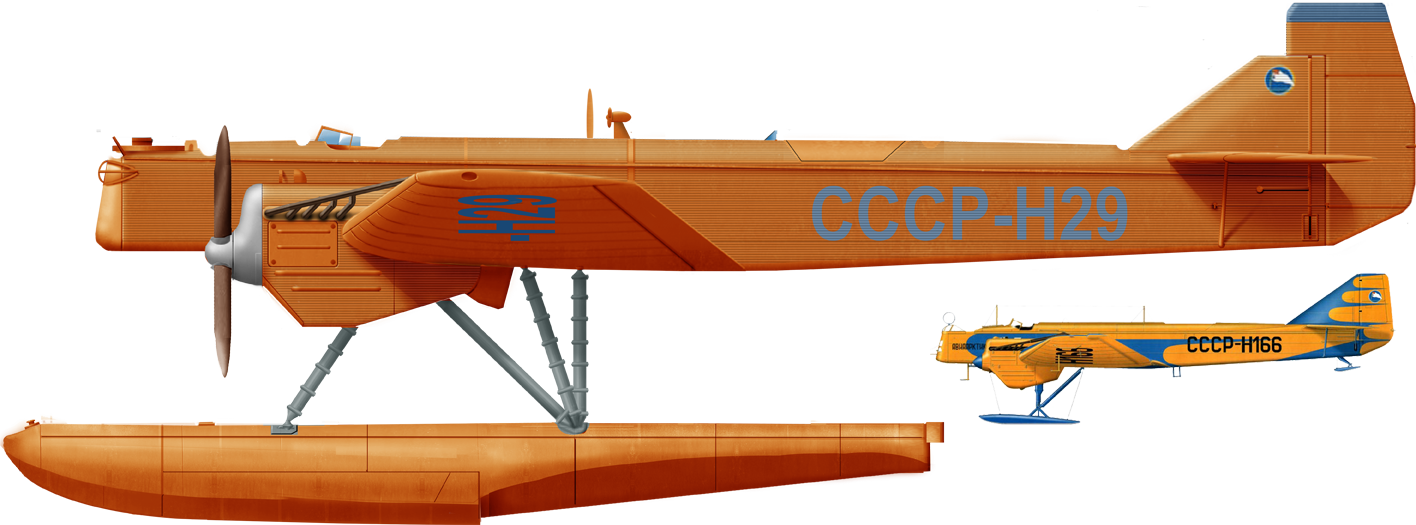
Volopianov and Liapidevski model of the Arctic expedition of 1935
Photos
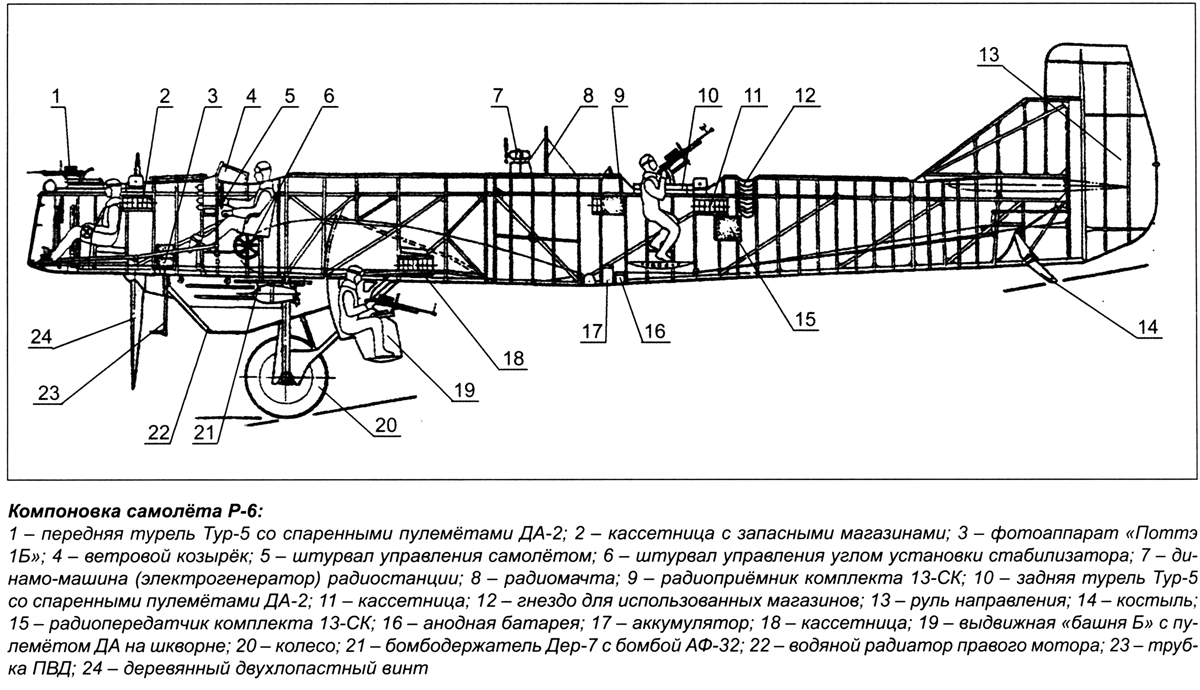

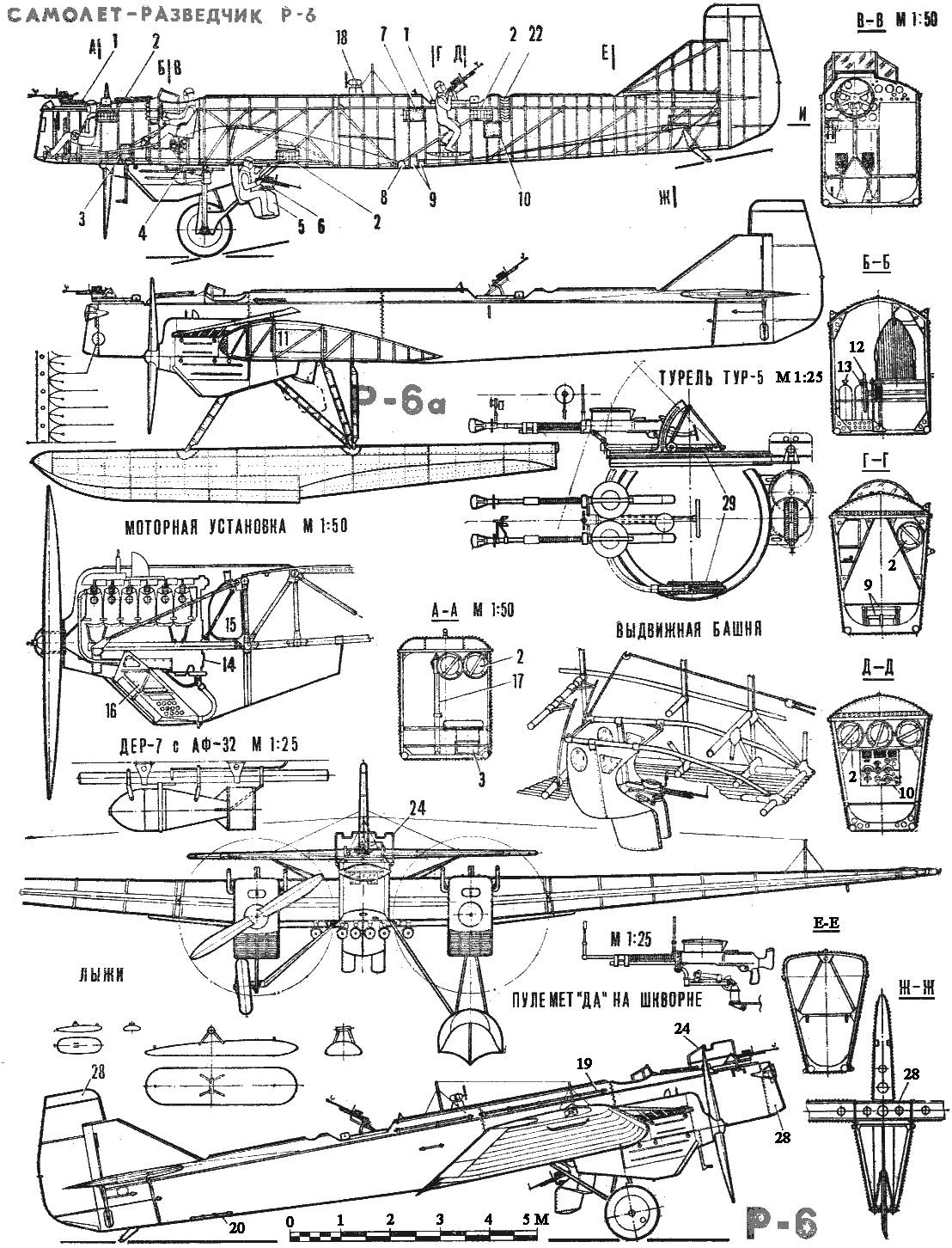

First flight demonstration on Lake Ladoga.
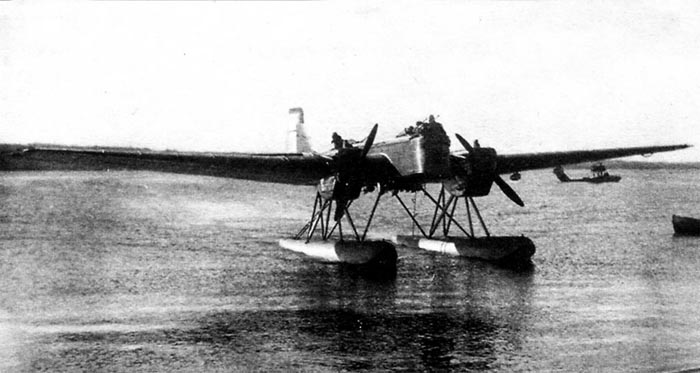
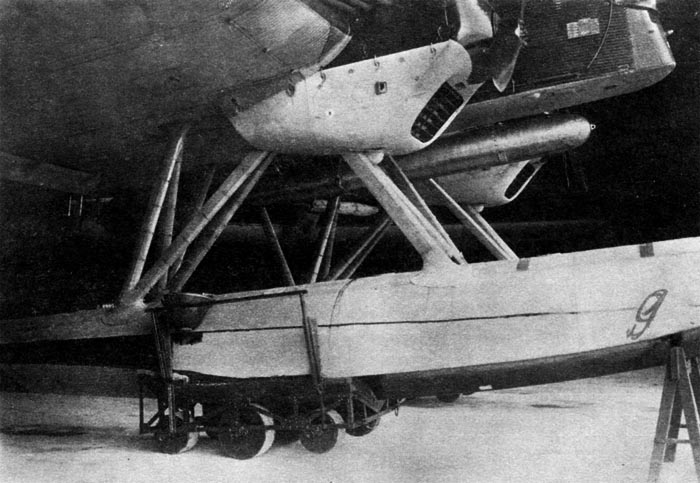
Note: It's the only photo i could find showing the bird could lift a torpedo. This seems to have been tested once, but with an only 500 kgs payload her flight has been probably sluggish at best.
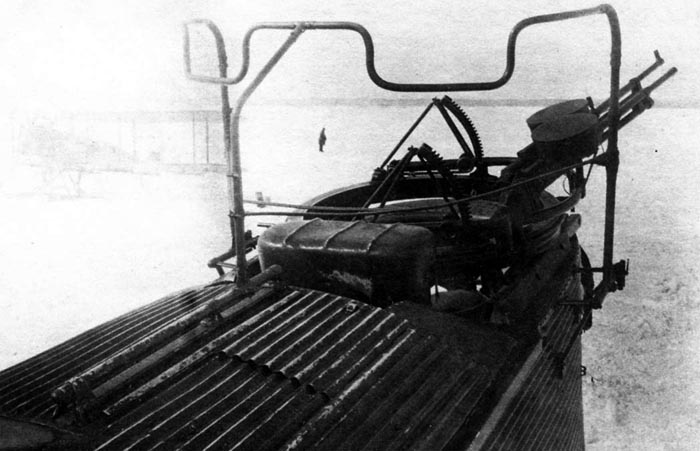
Forward gun position (bow or nose)

Dorsal twin DA-2 gun position
Read More
Books
Gunston, Bill. Tupolev Aircraft since 1922. — Naval Institute Press, 1995.Avions 94. V. Kulikov, V.Kotel'nikov. Tupolev ATN-7 and derivatives, the "sea sickness".
Putnam. Bill Gunston. Tupolev Aircraft since 1922
Midland. Yefim Gordon, Vladimir Rigmant. OKB Tupolev
Putnam. Lennart Andersson. Soviet Aircraft and Aviation 1917-1941
SAE Int. Paul Duffy, Andrei Kandalov. Tupolev. The man and his aitcraft
Links
on ru.wikipedia.org/Tupolev_ANT-7
on airwar.ru/
armedconflicts.com
on archive.org/ tupolevaircrafts1922guns
svavia.ru
- Lohner E (1913)
- Macchi M3 (1916)
- Macchi M5 (1918)
- Ansaldo ISVA (1918)
- Sopwith Baby (1916)
- Short 184 (1916)
- Fairey Campania (1917)
- Sopwith Cuckoo (1917)
- Felixstowe F.2 (1917)
- Friedrichshafen FF 33 (1916)
- Albatros W4 (1916)
- Albatros W8 (1918)
- Hanriot HD.2
- Grigorovitch M5
- IJN Farman MF.7
- IJN Yokosho Type Mo
- Yokosho Rogou Kougata (1917)
- Yokosuka Igo-Ko (1920)
- Curtiss N9 (1916)
- Aeromarine 39
- Vought VE-7
- Douglas DT (1921)
- Boeing FB.5 (1923)
- Boeing F4B (1928)
- Vought O2U/O3U Corsair (1928)
- Blackburn Blackburn (1922)
- Supermarine Seagull (1922)
- Blackburn Ripon (1926)
- Fairey IIIF (1927)
- Fairey Seal (1930)
- LGL-32 C.1 (1927)
- Caspar U1 (1921)
- Dornier Do J Wal (1922)
- Rohrbach R-III (1924)
- Mitsubishi 1MF (1923)
- Mitsubishi B1M (1923)
- Yokosuka E1Y (1923)
- Nakajima A1N (1927)
- Nakajima E2N (1927)
- Mitsubishi B2M (1927)
- Nakajima A4N (1929)
- CANT 18
WW1
✠ K.u.K. Seefliegerkorps:
 Italian Naval Aviation
Italian Naval Aviation
 RNAS
RNAS
 Marineflieger
Marineflieger
 French Naval Aviation
French Naval Aviation
 Russian Naval Aviation
Russian Naval Aviation
 IJN Air Service
IJN Air Service
 USA
USA
Interwar
 Interwar US
Interwar US
 Interwar Britain
Interwar Britain
 Interwar France
Interwar France
 Interwar Germany
Interwar Germany
 Interwar Japan
Interwar Japan
 Interwar Italy
Interwar Italy
- Curtiss SOC seagull (1934)
- Grumman FF (1931)
- Curtiss F11C Goshawk (1932)
- Grumman F2F (1933)
- Grumman F3F (1935)
- Northrop BT-1 (1935)
- Grumman J2F Duck (1936)
- Consolidated PBY Catalina (1935)
- Brewster/NAF SBN-1 (1936)
- Curtiss SBC Helldiver (1936)
- Vought SB2U Vindicator (1936)
- Brewster F2A Buffalo (1937)
- Douglas TBD Devastator (1937)
- Vought Kingfisher (1938)
- Curtiss SO3C Seamew (1939)
- Douglas SBD Dauntless (1939)
- Grumman F4F Wildcat (1940)
- F4U Corsair (NE) (1940)
- Brewster SB2A Buccaneer (1941)
- Grumman TBF/TBM Avenger (1941)
- Consolidated TBY Sea Wolf (1941)
- Grumman F6F Hellcat (1942)
- Curtiss SB2C Helldiver (1942)
- Curtiss SC Seahawk (1944)
- Grumman F8F Bearcat (1944)
- Ryan FR-1 Fireball (1944)
- Douglas AD-1 Skyraider (1945)
Fleet Air Arm
- Fairey Swordfish (1934)
- Blackburn Shark (1934)
- Supermarine Walrus (1936)
- Fairey Seafox (1936)
- Blackburn Skua (1937)
- Short Sunderland (1937)
- Blackburn Roc (1938)
- Fairey Albacore (1940)
- Fairey Fulmar (1940)
- Grumman Martlet (1941)
- Hawker sea Hurricane (1941)
- Brewster Bermuda (1942)
- Fairey Barracuda (1943)
- Fairey Firefly (1943)
- Grumman Tarpon (1943)
- Grumman Gannet (1943)
- Supermarine seafire (1943)
- Blackburn Firebrand (1944)
- Hawker Sea Fury (1944)
IJN aviation
- Aichi D1A "Susie" (1934)
- Mitsubishi A5M "Claude" (1935)
- Nakajima A4N (1935)
- Yokosuka B4Y "Jean" (1935)
- Mitsubishi G3M "Nell" (1935)
- Nakajima E8N "Dave" (1935)
- Kawanishi E7K "Alf" (1935)
- Nakajima B5N "Kate" (1937)
- Kawanishi H6K "Mavis" (1938)
- Aichi D3A "Val" (1940)
- Mitsubishi A6M "zeke" (1940)
- Nakajima E14Y "Glen" (1941)
- Nakajima B6N "Jill" (1941)
- Mitsubishi F1M "pete" (1941)
- Aichi E13A Reisu "Jake" (1941)
- Kawanishi E15K Shiun "Norm" (1941)
- Nakajima C6N Saiun "Myrt" (1942)
- Yokosuka D4Y "Judy" (1942)
- Kyushu Q1W Tokai "Lorna" (1944)
Luftwaffe
- Arado 196 (1937)
- Me109 T (1938)
- Blohm & Voss 138 Seedrache (1940)
Italian Aviation
- Savoia-Marchetti S.55
- IMAM Ro.43/44
- CANT Z.501 Gabbiano
- CANT Z.506 Airone
- CANT Z.508
- CANT Z.511
French Aeronavale
- GL.300 (1926-39)
- Levasseur PL.5 (1927)
- Potez 452 (1935)
- Loire 210 (1936)
- Loire 130 (1937)
- LN 401 (1938)
Soviet Naval Aviation
- Shavrov SH-2 (1928)
- Tupolev TB-1P (1931)
- Beriev MBR-2 (1930)
- Tupolev MR-6 (1933)
- Tupolev MTB-1 (1934)
- Beriev Be-2 (1936)
- Polikarpov I16 naval (1936)
- Tupolev MTB-2 (1937)
- Ilyushine DB-3T/TP (1937)
- Beriev Be-4 (1940)
-
Skoda Š-328V
R-XIII Idro
Fokker C.XI W (1934)
WW2
- De Havilland Sea Vixen
- Hawker Sea Hawk
- Supermarine Scimitar
- Blackburn Buccaneer
- Hawker Sea Harrier
- Douglas A4 Skyhawk
- Grumman F9F Panther
- Vought F8 Crusader
- McDonnell-Douglas F-4 Phantom-II
- North Am. A5 Vigilante
- TU-142
- Yak 38 forger
☢ Cold War
✧ NATO
 Fleet Air Arm
Fleet Air Arm
 US Navy
US Navy
☭ Warsaw Pact
Merch

Seafire Mark 45; HMS Pretoria Castle

Zeros vs its aversaries

Aichi D3A “Val” Junyo

Mitsubishi A5M poster

F4F wildcat

Macchi M5

SBD Dauntless Coral Sea

SBD Dauntless USS Enterprise

SBD-4 CV22
